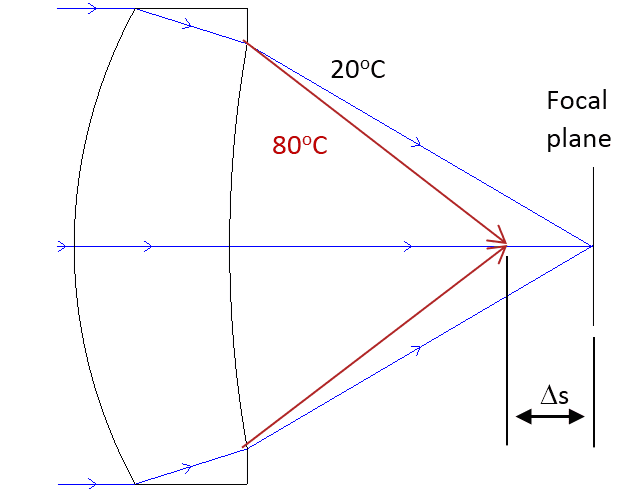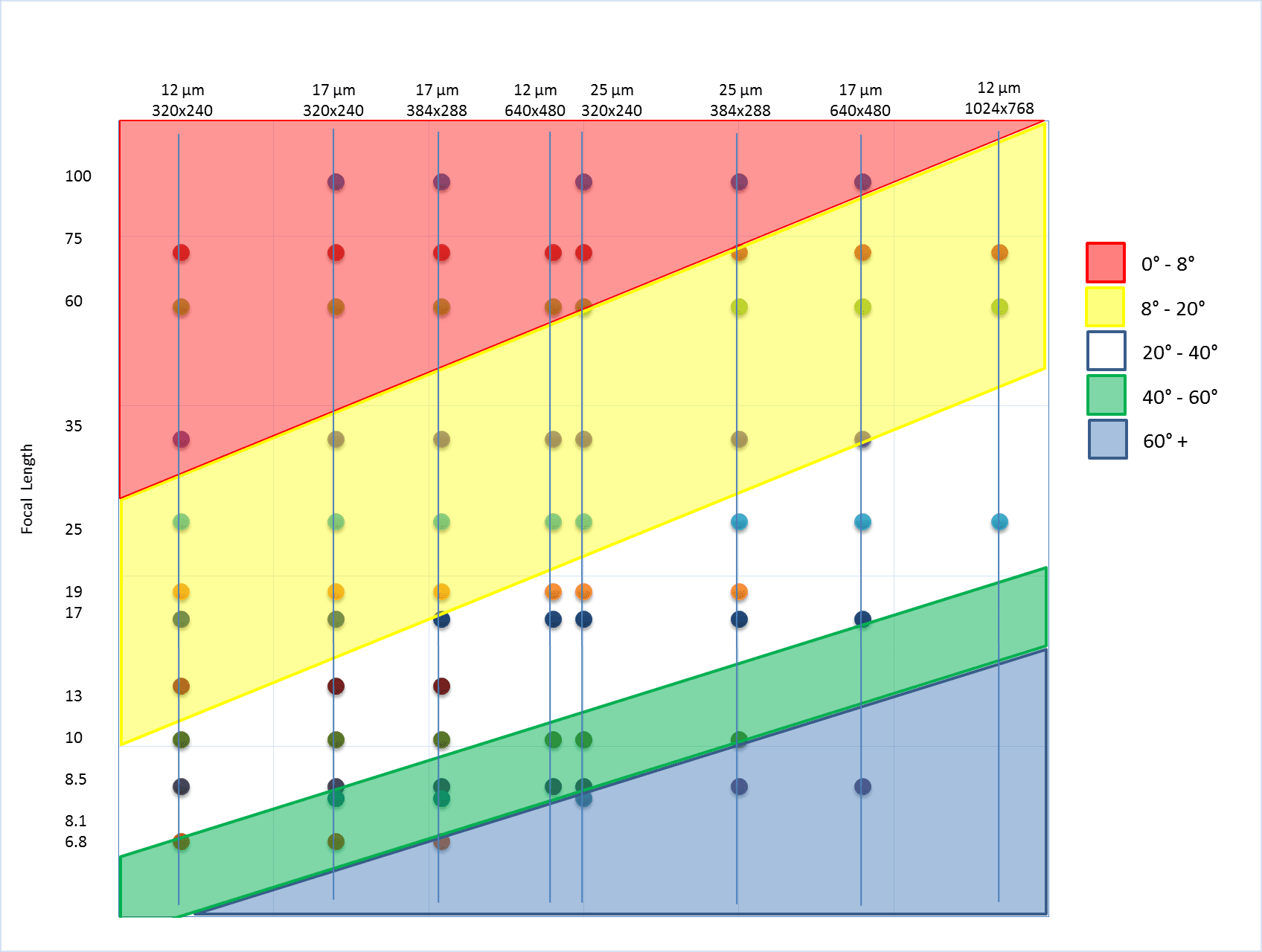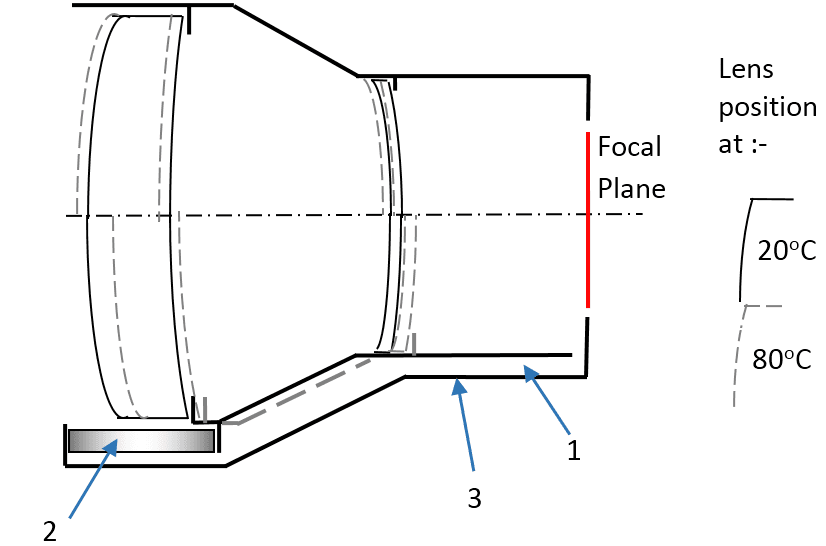Designing athermal lenses for LWIR systems
Introduction
Due to advances in materials and manufacturing technologies, the vast majority of lenses used on long-wave infrared (LWIR) cameras are simple: One- or two- element designs with an emphasis on low-cost manufacturing. One effect of this is that most of these cameras are supplied without any means for the user to focus them. This means that the lens must stay in focus over a broad range of temperatures. Since the standard temperature range for use outdoors is -40 °C (really cold) to +85 °C (much too hot!), this can provide some interesting design challenges.
The Problem
Most materials have properties that change with temperature, and all the materials that can be used to make lens for the LWIR waveband have properties that change. For optical performance, there are two relevant properties to consider: the thermal expansion (α), and the way the refractive index changes with temperature (dn/dT). The refractive index (n) defines the optical power of a lens —he higher the index, the stronger the lens — and this changes with wavelength. Figure 1 shows how these combine to cause a change (Δs) in the distance from the lens to the focal plane.

Figure 1: Typical change in focus for IR lens materials
These parameters can be combined mathematically to give the thermal drift (γ) as shown in the equation below.
One of the difficulties in designing lenses for the IR waveband is that there is a very small number of materials available. Table 1 shows the thermal parameters for the typical LWIR lens materials.
Table 1: LWIR Lens Materials
| Germanium | GASIR®1 | Zinc Selenide | Zinc Sulphide | |
|---|---|---|---|---|
| Refractive Index at 10 μm | 4.003 | 2.494 | 2.406 | 2.200 |
| dn/dT (x10-6 °C-1) | 396 | 55 | 61 | 39 |
| α (x10-6 °C-1) | 5.7 | 17.0 | 7.1 | 6.6 |
| γ (x10-6 °C-1) | 126 | 19.9 | 36.6 | 25.9 |
Germanium is frequently used for LWIR lenses due to its high refractive index, but, it also has a very large thermal drift, which means that it will have the biggest defocus with temperature.
It is also necessary to consider what happens to the housing that holds the lenses in place. Here it is only the thermal expansion that needs to be considered. Aluminium is frequently used as a lens housing, and this has a thermal expansion coefficient (α) of 23 x 10-6 °C-1. If we consider an aluminium housing 20 mm long, it is easily calculated that, for a temperature increase of 60 °C, the length increases by 28 microns.
This is not a large number, but it is about the same as the depth of focus for many LWIR lenses.
The thermal properties of the lens and the housing tend to add together and give the inconvenient effect of making the lens out of focus at high and low temperatures.
The Solutions
There are a variety of design solutions available to correct this problem and ensure that the camera stays in focus over the desired temperature range.
Active Mechanical
Conceptually, active mechanical athermalization is the simplest solution, although it is also the most expensive. In this case, a focus mechanism is used to bring the image back into focus. For a handheld device, the user could adjust focus until the image is sharp. For a remotely mounted camera, a motor-driven focus mechanism and control circuitry are required. In both cases, there is a size, weight, and cost penalty.
Passive Mechanical
The next strategy is passive mechanical athermalization. In this approach, a mechanical mechanism moves the lens to the correct focus position for different temperatures. Importantly, the mechanism works solely by exploiting the thermal characteristics of the housing materials.
Figure 2 is an illustration demonstrating how this can work. The housing consists of an inner cell (1) and an outer cell (3), separated by a spacer (2). The length and material of the spacer are chosen to attain a thermal expansion equal and opposite to the combined effect of the lenses and rest of the housing over the whole temperature range. The spacer then pushes the inner cell back to right position to keep the lens in focus.
Figure 2: Illustration of a lens assembly with (bottom half) and without (top half) Passive Mechanical Athermalisation.
Naturally, this is not simple in practice. Appropriate choice of housing materials is essential, and the materials that have the correct thermal properties frequently have other, undesirable properties.
It can also be seen that this approach requires significant extra mechanical complexity. This results in a bigger, heavier, and more costly solution than the simple mount.
Passive Optical
Passive optical athermalization is the Holy Grail for thermal correction. In this approach, you use the optical and thermal properties of the lenses to design a system with a minimal change in focal plane position with temperature. It is easy to see why this would be desirable. There is no need for any mechanical mechanism, so this approach gives the simplest, smallest, lightest, and cheapest solution.
The concept is easy. In a two lens system, choose lens materials so that the thermal defocus from each lens is equal and opposite. Even better, choose materials so the thermal defocus is not quite equal, so that remainder is enough to compensate for the contribution from the housing. In practice, this is not always possible. Since the typical LWIR materials all have a positive thermal drift, it is necessary to have significant negative optical power to have a significant negative contribution to the total thermal defocus. This limits the design solution to a small sub-set of possible layouts, none of which may be suitable for the task at hand.
It can be seen in table 1, that there is a big variation in thermal drift. For some lenses, it is sufficient to choose GASIR®1 instead of Germanium. This will reduce the impact of thermal defocus from the lenses by a factor of five. For shorter focal lengths, this is often enough to eliminate the need for any mechanical Athermalisation. Many of the catalogue lenses offered by Umicore use this advantage of GASIR®1 to offer small, cost-effective solutions.
Implementation
 Choosing the right solution is part of what makes a designer’s life interesting. The user will define what is most important to them in any optical system and that will change the priorities. Fortunately, there are some things that everyone wants. Good imaging performance, low cost, low weight, and compact size are on almost everybody’s list. With this in mind, Umicore has a range of catalogue lenses that use passive optical and passive mechanical athermalization to give engineers fast access to the latest in optical technology. One example is Umicore’s f=35mm f/1.1 catalogue lens, shown in Figure 3. This lens was designed for use with a broad range of detectors up to and including the VGA 12 micron and 17 micron detectors. It uses passive optical athermalisation to enable the lens to fit into a tiny package — 38mm in diameter and 25mm long, weighing only 37 grams.
Choosing the right solution is part of what makes a designer’s life interesting. The user will define what is most important to them in any optical system and that will change the priorities. Fortunately, there are some things that everyone wants. Good imaging performance, low cost, low weight, and compact size are on almost everybody’s list. With this in mind, Umicore has a range of catalogue lenses that use passive optical and passive mechanical athermalization to give engineers fast access to the latest in optical technology. One example is Umicore’s f=35mm f/1.1 catalogue lens, shown in Figure 3. This lens was designed for use with a broad range of detectors up to and including the VGA 12 micron and 17 micron detectors. It uses passive optical athermalisation to enable the lens to fit into a tiny package — 38mm in diameter and 25mm long, weighing only 37 grams.

Figure 4: Umicore's quick reference lens table
Since there are a very large number of detector formats available on the market today, Umicore has developed a quick reference table for engineers to use to determine which Umicore lens can be used with which detector, and what the horizontal field of view will be. This table is shown in Figure 4. A dot on the table indicates a viable detector/lens combination. The color banding shows the horizontal field of view for that combination. All of these lenses are available with athermalization using either passive optical or passive mechanical method. Full details of the imaging performance of these lenses and temperature ranges are given on our product range.
Conclusion
There is not a “one size fits all” solution to athermalization, and it is necessary to find the best design compromise for the particular problem. Finding this will involve optical, mechanical, and system design competence and a good understanding of the end user’s requirements. This will often be a combination of approaches. For example, it is common to use some element of passive optical athermalization to minimize the demands on a passive mechanical athermalization mechanism. Umicore has implemented these technologies into its range of catalogue lenses so that the most effective solution can be available off-the-shelf.
(JF)
Published October 24th 2014
